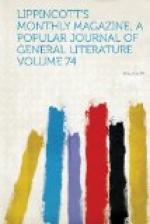“Robinson Crusoe” is a treasure-house of situations, some of which gain a piquancy from the dash of the diabolical with which Crusoe’s terrors invested them. Even where this is wanting there is plenty of bloodshed to take its place, and a happy combination of horrors is supplied by the cannibal feast which Crusoe interrupts. The youngest member of the troupe is, on the whole, the best victim; but, failing this, any pet animal sufficiently lazy or good-tempered to endure the process makes a tolerable substitute. “Masterman Ready,” “The Swiss Family Robinson,” and other cognate works, together with appropriate selections from sacred and profane history, are adapted with a shamelessness which would make a dramatic author’s blood run cold.
Lions, tigers, and wild beasts generally are common objects of nursery imitation, either from a genuine admiration of their qualities or from the mysterious craving for locomotion on all-fours with which children seem possessed. This branch of the art, however, struggles under some difficulties. It has, of course, to contend with the undisguised opposition of authority. This is hardly a matter for marvel, and perhaps not even a matter for regret. A prudential regard for the knees of puerile knickerbockers and the corresponding region of feminine frocks may explain a good deal of parental discouragement in the matter; and there is little public sympathy to counteract this, for it is felt that the total decay of these mimes would not be a serious loss either to dramatic art or to peace and quietness.
In one sense, no doubt, these amusements of childhood are matters of little moment; but, in spite of their seeming triviality, they have a genuine importance which should not be overlooked. The spontaneous exhibitions of children at play often reveal latent tastes, tendencies, or traits of character to one who is able to interpret them aright. If this be so,—and it is no longer open to doubt,—it is clear that even infant acting may furnish hints and assistance of the highest value to an intelligent system of education. It is true, no doubt, that till quite lately any such possibility was steadily ignored; but it is only quite lately that anything like an intelligent system of early education has been attempted. The idiosyncrasies of a child, instead of being carefully observed, were either disregarded as meaningless or repressed as being naughty. No greater mistake could be possible; and this at last is beginning to be understood. The first struggles of a young consciousness to express itself externally are nearly always eccentric, and often seem perverse. But this is nothing more than we ought to expect. The oddities of a child’s conduct are in reality nothing else than direct expressions of character, uncurbed by the conventions which regulate the demeanor of adults, or direct revelations of some taste or aptitude, which education may foster, but which neglect will hardly crush. The world contains a woful




